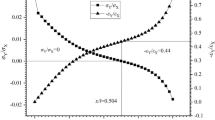Abstract
In this study, we investigate a method to detect damage in a laminated composite structure by analyzing its dynamic response to impact loads. The combined finite element method (FEM) with seven degrees of freedom (DOF) and the advanced microgenetic algorithm described in this paper may allow us not only to detect the damaged elements but also to find their locations and the extent of damage. A high order shear deformation theory (HSDT) is used to predict the structural behavior and to detect damage of laminated composite plates. The effects of noise associated with the uncertainty of measurements due to the complex nature of composites are considered for [0/90] s and [±45] s layup sequences. The results indicate that the new method is computationally efficient in characterizing damage for complex structures such as laminated composites.
Similar content being viewed by others
References
Abu-Lebedh G, Benekothal RF (1999) Convergence variability and population sizing in micro-genetic algorithms. Comp.-Aided Civil and Infra. Eng. 14:321–334
Au FTK, Cheng YS, Tham LG Bai ZZ (2003) Structural damage detection based on a micro-genetic algorithm using incomplete and noisy modal test data. J. Sound Vib. 259(5):1081–1094
Bathe KJ (1996) The finite element procedures in engineering analysis. Prentice Hall, Englewood Cliffs, NJ:768–785
Carroll DL (1996) Chemical laser modeling with genetic algorithms. AIAA J. 34(2):338–346
Carroll DL (1996) Genetic Algorithms and Optimizing Chemical Oxygen-Iodine Lasers. Developments in Theoretical and Applied Mechanics. H.B. Wilson et al. (Eds), School of Engineering, The University of Alabama, 9:411–424
Chou JH, Ghaboussi J (2001) Genetic algorithm in structural damage detection. Comput. Struct. 79:1335–1353
Christides S, Barr ADS (1984) One-dimensional Theory of Cracked Bernulli-Euler Beams. Int. J. Mech. Sci. 26(11/12):639–648
Doebling SW, Farrar CR, Prime, MB (1998) A summary review of vibration-based damage identification methods. Shock Vib. Digest 30:91–105
FORTRAN Genetic Algorithm (GA) Driver. (2001), 〈http://cuaerospace.com/carroll/ga.html〉 (Dec. 10, 2002)
Friswell MI, Penny JET, Garvey SD (1998) A combined genetic and eigensensitivity algorithm for the location of damage in structures. Comput. Sturct. 69:547-556
Goldberg DE (1989) Sizing populations for serial and parallel genetic algorithms. Proc. 3rd Conf. Genetic Algori. Fairfax, VA, 5:29–37.
Goldberg DE (1989) Genetic Algorithms in Search, Optimization and Machine Learning. Addison-Wesley, MA
Gudmudson P (1982) The Dynamic Behaviors of Slender Structures With Cross Section Cracks. J. Mech. and Phys. Of Solids, 31(4):329–345
Krawczuk M (2002) Application of spectral beam finite element with a crack and iterative search technique for damage detection. Finite Elements in Analysis and Design 38:537–548
Krishnakumar K (1989) Micro-genetic algorithms for stationary and non-stationary function optimization. SPIE, 1196: 289–296
Lee SY, Wooh SC, Yhim SS (2004) Dynamic behavior of folded composite plates analyzed by the third order plate theory. Int. J. Solids and Struct. 41(7):1879–1892
Mares C, Surace C (1996) An application of genetic algorithms to identify damage in elastic structures. J. Sound Vib. 195:195–0215
Morassi A, Rollo M (2001) Identification of two cracks in a simply supported beam from minimal frequency measurements. J. Sound Vib. 7:729–739
Ostachowicz WM, Krawczuk M (1991) Analysis of the effect of cracks on the natural frequencies of a cantilever beam. J. Sound Vib. 150:191–201
Reddy JN, Phan ND (1985) Stability and vibration of isotropic, orthotropic, and laminated plates according to a higher-order shear deformation theory. J. Sound. Vib. 98:157–170
Reddy JN (1997) Mechanics of laminated composite plates: Theory and Analysis. CRC Press, Boca Raton, FL
Rizos PF, Aspragathos N, Dimarogonas, AD (1990) Identification of crack location and magnitude in a cantilever beam from the vibration modes. J. Sound Vib. 138:381–388
Ruotolo R, Shifrin EI (1999) Natural frequencies of a beam with arbitrary number of cracks. J. Sound Vib. 223(3):409–423
Salawu OS (1997) Detection of structural damage through change in frequency: A review. Engng. Struct. 19(9):718–723
Suh MW, Shim MB, Kim MY (2000) Crack identification using hybrid neuro-genetic technique. J. Sound Vib. 238(4):617–635
Wooh SC, Daniel IM (1991) Mechanical characterization of a unidirectional composite by ultrasonic method. J. Acoust. Soc. of America, 90(6):3248–3253
Wooh SC, Wei C (1999) A high-fidelity ultrasonic pulse-echo scheme for detecting delaminations in composite laminates. Composites Part B: Engineering 30(5):433–441
Yang JCS, Tsai T, Pavlin V, Chen J, Tsai WH (1985) Structural damage detection by the system identification technique. Shock Vib. 55:57–68
Author information
Authors and Affiliations
Corresponding author
Rights and permissions
About this article
Cite this article
Lee, SY., Wooh, SC. Detection of stiffness reductions in laminated composite plates from their dynamic response using the microgenetic algorithm. Comput Mech 36, 320–330 (2005). https://doi.org/10.1007/s00466-005-0669-2
Received:
Revised:
Accepted:
Published:
Issue Date:
DOI: https://doi.org/10.1007/s00466-005-0669-2




